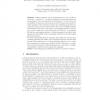35 search results - page 3 / 7 » Computation of distances for regular and context-free probab... |
IANDC
2007
13 years 5 months ago
2007
The edit distance (or Levenshtein distance) between two words is the smallest number of substitutions, insertions, and deletions of symbols that can be used to transform one of the...
FCT
2005
Springer
13 years 11 months ago
2005
Springer
Leftist grammars can be characterized in terms of rules of the form a → ba and cd → d, without distinction between terminals and nonterminals. They were introduced by Motwani e...
FUIN
2010
13 years 3 months ago
2010
Abstract. A (combinatorial) channel consists of pairs of words representing all possible inputoutput channel situations. In a past paper, we formalized the intuitive concept of “...
JUCS
2002
13 years 5 months ago
2002
: We study additive distances and quasi-distances between words. We show that every additive distance is finite. We then prove that every additive quasi-distance is regularity-pres...
COLING
1996
13 years 6 months ago
1996
This paper studies the computational complexity of disambiguation under probabilistic tree-grammars as in (Bod, 1992; Schabes and Waters, 1993). It presents a proof that the follo...

